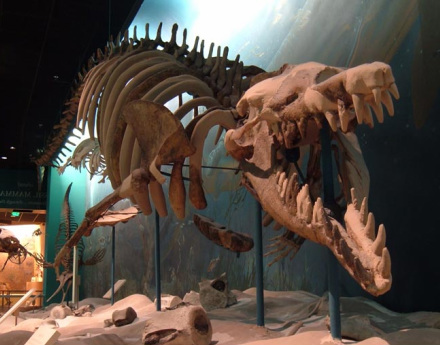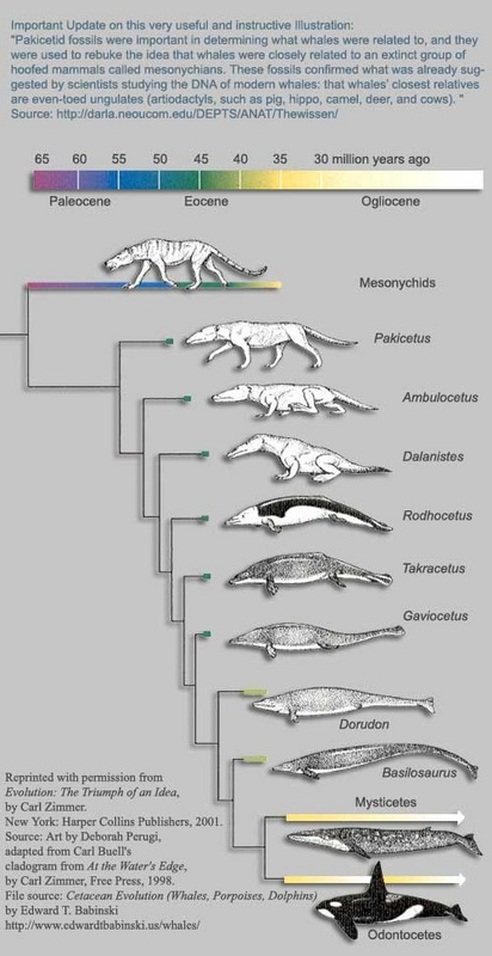Basilosaurus certoides- an Ancient Whale
The Basislosaurus, meaning "King Lizard," is a cetacean that lived in the late Eocene, around 40 million years ago. Contrary to its name, the Basilosaurus is not actually a lizard at all but an archeocete, an ancient whale. This marine mammal lived in the Gulf of Mexico and fossils can be found today in the southern states bordering the Gulf. In fact, the Basilosaurus is the state fossil of both Mississippi and Alabama. Like its conflicting name, this ancient animal has had a shifting evolutionary history, filled with mistakes and later corrections. However, although the history of the Basilosaurus is still somewhat unkown, it plays an integral role in the evolution of life.
The Structure and Movement of an Ancient Whale
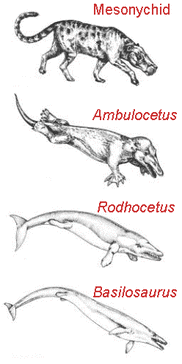
The Basilosaurus has a unique physical structure that can be traced back to the lobe-finned fish. This marine mammal possessed sturdy flippers supported by the bone-structure in the fins of the lobe-finned fish that lived almost 375 million years ago. In addition, the lobe-finned fish passed down the spinal chord and notochord to all chordates, such as the Basilosaurus
Likewise, the Basilosaurus had a long flexible body for locomotion and stable neck to swim effectively. The transitional fish tiktaalik is noted to have the first neck, which became more stable over time. The Rhodocetus, an early ancient whale from the middle Eocene, had short vertebrae to stabilize the neck for swimming. The Basilosaurus inherited this well-supported neck to swim properly in its environment.
The Mesonychids were wolf-sized carnivores who scientists believe may have lost their terrestrial characteristics and went back to the marine environment, leading to whales. The mesonychids had distinct specialized teeth that are similar to the triangular teeth of the Basilosaurus. The mesonychids also had an elongated skulls seen in the skull of the Basilosaurus. When transitioning to live in the sea, the mesonychids developed weak vestigial hind legs which the Basilosaurus had as well. These hind limbs were too weak for the ancient whale to go on land.
Likewise, the Basilosaurus had a long flexible body for locomotion and stable neck to swim effectively. The transitional fish tiktaalik is noted to have the first neck, which became more stable over time. The Rhodocetus, an early ancient whale from the middle Eocene, had short vertebrae to stabilize the neck for swimming. The Basilosaurus inherited this well-supported neck to swim properly in its environment.
The Mesonychids were wolf-sized carnivores who scientists believe may have lost their terrestrial characteristics and went back to the marine environment, leading to whales. The mesonychids had distinct specialized teeth that are similar to the triangular teeth of the Basilosaurus. The mesonychids also had an elongated skulls seen in the skull of the Basilosaurus. When transitioning to live in the sea, the mesonychids developed weak vestigial hind legs which the Basilosaurus had as well. These hind limbs were too weak for the ancient whale to go on land.
Senses of the Basilosaurus
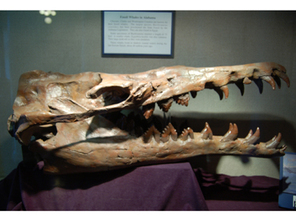
The skull of the Basilosaurus
The Basilosaurus had a specialized ear region in its skull that allowed the animal to hear well underwater. However, the skull revealed that this marine mammal had a small brain compared other whales. The tiny brain leads scientists to believe today that the Basilosaurus lacked the social capabilities of modern whales.
Evolution of Whales- From Land to Sea
Basilosaurus Reproduction: Connection to Modern Whales
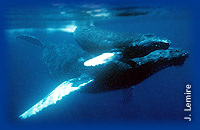
The Basilosaurus was a placental mammal, meaning that it had a long gestation and short suckling period. Like all whales, this animal is of the eutheria group. However, studies have shown that certain animals such as modern toothed whales have both a long gestation and long suckling period. Unfortunately, the length of the suckling period of the Basilosaurus is unkown.
Like whales today, the Basilosaurus gave live birth in its marine environment. As a mammal the Basilosaurus had a nipple to feed its young. Whales today exhibit parental care like other mammals.
Although the reproductive strategies of the Basilosaurus is relatively unkown, much can be learned from their whale descendants. For instance, because both modern and ancient whales cannot move on land, scientists believe that the Basilosaurus mated in the water. One common view is that the hind legs were used for grasping in reproduction. However, modern whales lack these hind limbs and thus mate either side to side or on their stomachs.
Like whales today, the Basilosaurus gave live birth in its marine environment. As a mammal the Basilosaurus had a nipple to feed its young. Whales today exhibit parental care like other mammals.
Although the reproductive strategies of the Basilosaurus is relatively unkown, much can be learned from their whale descendants. For instance, because both modern and ancient whales cannot move on land, scientists believe that the Basilosaurus mated in the water. One common view is that the hind legs were used for grasping in reproduction. However, modern whales lack these hind limbs and thus mate either side to side or on their stomachs.
